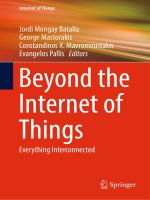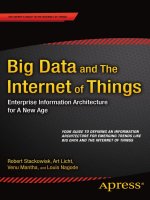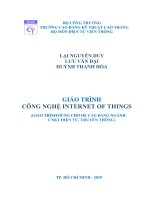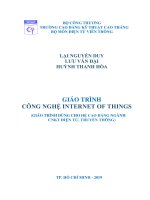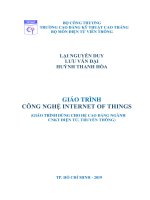information technology assignment 1 unit internet of things
Bạn đang xem bản rút gọn của tài liệu. Xem và tải ngay bản đầy đủ của tài liệu tại đây (1.05 MB, 37 trang )
<span class="text_page_counter">Trang 1</span><div class="page_container" data-page="1">
BTEC FPT INTERNATIONAL COLLEGE
INFORMATION TECHNOLOGY ASSIGNMENT 1
UNIT: INTERNET OF THINGS
STUDENT : PHAN LAM QUOC VIETCLASS : IT16101
STUDENT ID : BDAF200035
SUPERVISOR : TRUONG DANG HIEU
Da Nang, November 2022
</div><span class="text_page_counter">Trang 2</span><div class="page_container" data-page="2">ASSIGNMENT 1 FRONT SHEET
Submission date 4/11/2022 <sup>Date received (1st </sup>submission)
Re-submission date <sup>Date received (2nd </sup>
Student declaration:
I certify that the assignment submission is entirely my own work and I fully understand the consequences of plagiarism. I understand that making a false declaration is a form of malpractice.Student’s signature:
Quoc VietGrading grid:
</div><span class="text_page_counter">Trang 3</span><div class="page_container" data-page="3">❒
Summative Feedbacks: Resubmission Feedbacks:❒
Grade: Assessor Signature: Date:Internal Verifier’s Comments:
Signature & Date:
</div><span class="text_page_counter">Trang 5</span><div class="page_container" data-page="5">LIST OF TABLES AND FIGURES
</div><span class="text_page_counter">Trang 6</span><div class="page_container" data-page="6">LIST OF THE ACRONYM
ACL Access Control List OEM Original equipment manufacturerISV independent software vendor
</div><span class="text_page_counter">Trang 7</span><div class="page_container" data-page="7">In our present position as product developers at young start up, we create IoT solutions for clients in the consumer, business, government, and defence sectors. Our boss has given us the responsibility to plan and create a new IoT service, application, or product for a possible client as part of our employment. We must choose a target user, test our product on this person, and incorporate their comments into several iterative revisions.
In the first section, we'll plan an Internet of Things application for a particular target end user and the tests you want to run on this user. This strategy will be presented as a written document with supplementary information and materials, such as user personas and customer path maps. Make several versions of your program, and then alter each iteration with improvements gleaned through experimentation and user feedback. Let’s find out in this assignment!
CHAPTER 1: IOT APPLICATION PLANNING & DEVELOPMENT
</div><span class="text_page_counter">Trang 8</span><div class="page_container" data-page="8">CHAPTER 1: IOT APPLICATION PLANNING & DEVELOPMENT
1.1 Explore various forms of IoT functionality on electronic platform. (P1)1.1.1 What is IOT?
Over the past several years, the phrase "Internet of Things" (IoT) has become one of the most well-known "technology buzz" terms. Due to its quick expansion, IoT is a hot topic in technology conversations in today's globe. The IoT can be defined in a variety of ways.
IoT is defined as a method of connectivity using internet-connected devices that may be implanted to give commonplace items functionality by enabling them to transmit and receive data.Today, data permeates every aspect of our lives. As a result, IoT may also be described as the analysis of data that results in a meaningful action that is initiated following data exchange.
Figure: 1.1-1: Internet of Things1.1.2 History of IOT
As a part of DARPA (Defence Advanced Research Projects Agency), the internet was first developed in 1962. It then changed its name to ARPANET (Advanced Research Projects Agency Network) in 1969.
Commercial service providers started enabling public usage of ARPANET in the 1980s, which helped it develop into our current Internet. For much of the IoT, fundamental
communications are provided through satellites and landlines.
</div><span class="text_page_counter">Trang 9</span><div class="page_container" data-page="9">Early in 1993, the Department of Defence delivered a reliable, highly effective system of 24 satellites, making the Global Positioning System (GPS) a reality. Soon after, privately owned, commercial satellites were sent into orbit, further enhancing the functionality of the IIoT.
An early 1980s Coca-Cola machine at Carnegie Mellon University was one of the first examples of the Internet of Things, but the term itself wasn't used until 1999. Before making the journey to get a drink, local programmers would connect over the Internet to the refrigerator and check to see whether there was one available and if it was cold.
The term "Internet of Things" was first used by Kevin Ashton, the Executive Director of MIT's Auto-ID Labs, in 1999. Although he was the first to explain the Internet of Things in a presentation for Procter & Gamble, the concept has since changed.
Figure 1.1-2: Smart city and Self-car using IoT
2000's early years, the inventor of the term "Internet of Things," Kevin Ashton, thought Radio Frequency Identification (RFID) was a requirement for the Internet of Things. He came to theconclusion that computers could manage, track, and inventory all gadgets provided they were "tagged."
Walmart and the US Department of Defence were the first big companies to adopt Ashton'ssystem for monitoring inventories utilizing barcodes, RFID technology, and the Internet of Things in2002-2003.
The Swiss Federal Office of Energy launched the "Smart City Switzerland" pilot initiative in 2012. To debate fresh concepts for the urban environment, they gathered individuals from academia, industry, and government. With more than 60 active initiatives, Smart City Switzerland encourages new collaborations and innovation in science.
By 2013, the Internet of Things (IoT) had developed into a system utilizing a number of technologies, including wireless communication, embedded systems, micro-electromechanical
</div><span class="text_page_counter">Trang 10</span><div class="page_container" data-page="10">systems (MEMS), and the Internet. They entered the IoT in 2015 with a lot of marketing zeal. Marketing teams keep an eye on the sensors in these gadgets and send out promos based on the customer and the product's location.
The very first self-driving car debuted. May Mobility started a pilot program in October 2021 to test its self-driving software.
1.1.3 Characteristics of IOT Connectivity
An essential component of the IoT architecture is connectivity. The IoT infrastructure should be connected to IoT objects. This should always be guaranteed to be possible for everyone, everywhere, at any time.
For instance, connections between individuals via internet-connected devices like smartphones and other gadgets, as well as connections between individual Internet-connected objects like routers, gateways, sensors, etc.
Identity and intelligence.
It is crucial to extract knowledge from the produced data. For instance, a sensor could produce data, but that information won't be helpful until it is correctly evaluated. IoT devices each have an own identity.
The equipment may sometimes be tracked using this identity, and its condition can occasionally be inquired.
Architecture
IoT architecture can't be uniform in design. It must be hybrid and able to work with items from various manufacturers in the IoT network.
</div><span class="text_page_counter">Trang 11</span><div class="page_container" data-page="11">No engineering branch owns the Internet of Things. When several disciplines join together,IoT becomes a reality.
There are an increasing number of gadgets and appliances that are connected to the internet as a result of the Internet of Things, which is expanding exponentially. Additionally, there are an increasing number of cyber-attacks on these gadgets and appliances, thus it's critical to consider security while creating a good or service.
The concept behind the internet of things is that everything around us will be wired into the network, making life simpler for everyone. With this new technology, there are several hazards as well, though. It is crucial to take action to safeguard your personal information in order to avoid these threats and stay safe and secure.
Because personal information may be gathered and shared without permission, data privacy is a major problem with the internet of things. Other difficulties include those related to hacking, data ownership, and privacy.
1.1.4 Why use IOT?
Organizations may get a number of advantages from the internet of things. Some advantages are exclusive to certain businesses, while others apply to many other industries. The following are some typical advantages of IoT for businesses:
Monitor their whole company operations,promote staff productivity,
enhance customer experience.save time and money.
integrate and adapt business modelsMake better business choicesIncrease revenue.
IoT equips organizations with the resources they need to enhance their business strategies and challenges them to revaluate how they conduct their operations.
The use of IoT in agriculture can help farmers by simplifying their work. Sensors can gather information on soil composition, temperature, humidity, rainfall, and other variables that might aidin automating farming practices.
</div><span class="text_page_counter">Trang 12</span><div class="page_container" data-page="12">IoT can also assist with the capacity to monitor infrastructure-related processes. For instance, sensors might be used to track developments or changes in the structural elements of buildings, bridges, and other infrastructure. Benefits associated with this include cost savings, time savings, changes to the workflow's quality of life, and paperless workflow.
IoT may be used by a home automation company to control and monitor a building's electrical and mechanical systems. On a larger scale, smart cities may assist residents in using less garbage and energy.
Every industry, including those in healthcare, banking, retail, and manufacturing, is impacted by IoT.
1.1.5 Application of IOT Smart Healthcare
The healthcare sector has been harnessing the potential of the Internet of Things for applications that might save lives. The whole system of patient care may be enhanced with the deployment of IoT, from gathering crucial data from bedside devices to real-time diagnostic processes, accessing medical records and patient information across many departments.
Figure 1.1-3: Smart Healthcare
IoT will be convenient for medical professionals, enhance information accuracy (helping to eliminate data inaccuracy), boost overall efficiency, and shorten process times.
</div><span class="text_page_counter">Trang 13</span><div class="page_container" data-page="13">Smart IoT devices allow for continuous patient monitoring. A patient's immediate vital changes will instantly alert the appropriate medical professionals in real-time. Doctors can remotely check on patients' conditions and recommend appropriate surgeries as needed.
With the aid of intelligent IoT devices, doctors may remotely evaluate patients and remotely administer medication. Hospital visits may not always be necessary. For instance, many hospitals now provide telemedicine services. Patients can use video conferencing to continue their treatment.
In addition to improving the effectiveness and cost-effectiveness of healthcare systems, IoT increases patient pleasure. The use of IoT in healthcare will improve the whole hospital experience.
Autonomous Driving
Artificial intelligence and the Internet of Things' smart sensor technology have helped autonomous driving advance. Early autonomous vehicle generation (partial automation) will help drivers drive safely, prevent crashes, and issue warnings about the state of the road and the
Figure 1.1-4: Autonomous Driving
Examples include help with cruise control, parking, line-changing, and effective fuel/energy management, among others.
Using the Internet of Things and artificial intelligence, self-driving cars and linked car concepts will provide a significantly safer driving experience in the future (AI). The system uses cameras, proximity sensors, RADARs, and RF antenna arrays to gather data and support the
</div><span class="text_page_counter">Trang 14</span><div class="page_container" data-page="14">vehicle's decision-making in response to abrupt changes in the route. Using RF technology, vehiclesand intelligent objects may communicate and exchange information.
Examples of such situations include ice on the road, a car accident or breakdown on a single line, and heavy traffic on a highway in a certain direction.
Agriculture and Smart farming
To produce more foods and vegetables to feed the growing world population, agriculture and farming face several difficulties. The Internet of Things can help farmers and academics in this field discover more efficient and affordable ways to boost output.
Young people in industrialized nations are not drawn to traditional farming and agriculture. Authorities must come up with alternate solutions to this problem since a lack of support personnel might affect production.
One of the potential approaches to increasing overall agricultural and farming industry efficiency while using fewer personnel is the Internet of Things. Each stage of agriculture will be improved by smart sensor technology, and automation lessens the need for physical labour.
Figure 1.1-5: Agriculture and Smart farmingSmart Disaster management
Engineers can create a more effective emergency response system for industries, schools, hospitals, airports, and other public gathering areas thanks to the Internet of Things and its vast spectrum of smart sensors. Sensors will automatically identify any emergency scenarios, such as a fire breakout or floods, and will immediately transmit this information with the relevant task groups.
</div><span class="text_page_counter">Trang 15</span><div class="page_container" data-page="15">An alert on the situation will be sent to the local hospitals, police, ambulance units, and firedepartment during an emergency. An automated warning system enhances readiness and enables authorities to rapidly plan and respond to any crisis.
Smoke detectors, temperature sensors, humidity sensors, CO2 monitoring sensors, and precipitation detectors are a few examples of popular sensors.
Continuous monitoring of CO2 emission levels, fire, and smoke is being done using sensors that have been placed in numerous sites (where there is a higher chance of wildfire occurring).
These sophisticated sensors are linked to a network, enabling rapid detection of any data changes and the transmission of alert notifications in the event of a wildfire.
Figure 1.1-5: Smart Disaster managementSmart Home and Office
Applications for smart sensors in the home are growing in popularity right now. Any smart device may be set up, connected to the internet, and controlled by a straightforward smartphone app.
</div><span class="text_page_counter">Trang 16</span><div class="page_container" data-page="16">Figure 1.1-6: Smart Home and Office
One of the most common and economical Internet of Things solutions is smart locks and door entry systems. Using a web interface or smartphone app, smart locks are simple to set up anduse. One appealing internet of things application for the smart home is smart lighting. It not only helps us manage efficiently but also saves energy. Smart hub devices and smartphone apps may beused to adjust the lighting environment.
Gates and garages can be easily controlled (operated) using smart sensor technologies and the internet of things. You may use a mobile device to open or close the gate whenever you are going to enter the house or once you have left the property.
Smart sensors placed on the parking area are gathering data on parking space availability and real-time updating the database. It will immediately be updated after the space is filled.
We can effectively control this problem thanks to the Internet of Things and smart sensor technologies. Authorities will be able to estimate the quantity of garbage produced in a certain region, how to process effectively, initiate the clearing of waste, and evaluate data for future planning, among other things, with the help of a smart waste management system.
1.2 Review standard architecture, frameworks, tools, hardware and APIs available for use in IoT development. (P2)
1.2.1 Architecture of IOT
There are many uses for Internet of Things (IoT) technology, and its use is accelerating quickly. The Internet of Things functions as it was intended or created to in accordance with the many application areas for which it has been used. However, it lacks a widely adhered-to standard defined architecture of working. The functioning and application of IoT in various domains determine its architecture. However, there is a fundamental process flow upon which IoT is founded.
We'll talk about the IoT's four-stage basic architecture, which includes the sensing layer, network layer, data processing layer, and application layer.
+ Sensing Layer/Perception Layer: This layer contains sensors, actuators, and devices. Thesesensors and actuators receive data (physical and environmental factors), process it, and then transmit it across a network.
+ Network layer: Data acquisition systems (DAS) and Internet/Network gateways are present. Data aggregation and conversion tasks are carried out by DAS. Advanced gateways, which
</div><span class="text_page_counter">Trang 17</span><div class="page_container" data-page="17">primarily link Sensor networks to the Internet, also carry out a number of fundamental gateway functions, such as virus protection, filtering, and occasionally making decisions based on inputted data and data management services.
Figure 1.2-1: Architecture of IOT
+ Data processing Layer: This is the IoT ecosystem's processing layer. Prior to being sent to the data center, where it is accessible by software programs commonly referred to as business applications, the data is examined, pre-processed, and ready for further action.
+ Application Layer: The last layer of the IoT architecture's four tiers. The management of data occurs in data centers or the cloud, where it is used by end-user applications for things like agriculture, healthcare, aerospace, farming, and military.
1.2.2 Frameworks of IOT
The Internet of Things (IoT) Framework may be thought of as an ecosystem made up of several linked devices that interact with one another online. These Internet-connected gadgets often function to send and detect data while requiring very little human involvement.
The Internet of Things (IoT) architecture enables seamless communication between linked devices. Therefore, it should come as no surprise that it is known as the "Internet of Things"
</div><span class="text_page_counter">Trang 18</span><div class="page_container" data-page="18">framework, the framework that makes it possible for objects to communicate with one another through the Internet. With applications in practically every industry, the Internet of Things
framework is a crucial component of technology in the present world. For instance, the design of smart houses is one of the IoT's key applications.
Figure 1.2-2: IoT FrameworkArduino:
If you want to possess a computer that can observe the world and exert powerful control over it, Arduino is one of the most highly recommended open-source Internet of Things frameworks.
The IoT hardware and software components are included in the Arduino open source, which makes it highly straightforward and user-friendly. Several hardware requirements that are frequently used by interactive electronics help the Arduino open-source work more efficiently.
Figure 1.2-3: ArduinoFlutter
A processing core that may be readily designed for many electronic tasks is the Flutter open-source framework. Students and engineers love this open-source Internet of Things framework because it can be customized.
</div>




